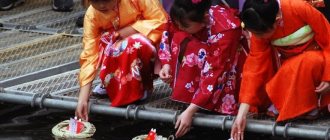The role of women in modern Japanese society
In many countries of the world community there is a radical rethinking of the social role of women in society. Priority measures to ensure her rights and realize her opportunities are determined. The equal participation of women in the political and economic life of the country is considered by the democratic public as necessary conditions for achieving progress in socio-economic development, in solving current political, socio-cultural, racial, ethnic and other problems.
However, the process of ensuring gender equality is still one of the rather complex processes on the way to truly ensuring equal opportunities for women and men in the exercise of their rights and freedoms, determined by gender policy, which is understood as a set of government decisions and measures aimed at ensuring the actual equality of women with men in all spheres of life and activity.
At the beginning of the 21st century, fundamentally new urgent problems are being put forward to determine the place of women in modern society, without solving which further progress of mankind is impossible. The largest and most influential group of the population, along with men, is increasingly drawn into the ranks of active supporters of socio-political transformations, the resolution of pressing contradictions, and the creation of a humane, fair, democratic society /1/.
Until the beginning of the twentieth century, most Japanese women spent all their time at home . Only occasionally did they visit relatives and friends; now these restrictions have been lifted. Women not only go to visit people, they also receive friends. But they are also actively introducing themselves into the public life of the country, working in all spheres of society.
Such women in Japan are called "kyariawomen" (English borrowing) - a woman making a career. However, despite the formal equality of women with men, social inequality of women in Japan continues to persist at all levels of the social hierarchy. Thus, discrimination against Japanese women still occurs in political and public life, despite the equality of the sexes /2/.
Equality is the essential foundation of any democratic society that strives for social justice and respect for human rights. In almost all societies and fields of activity, women are discriminated against in the family, in society and in the workplace . Although the causes and consequences of this may vary from country to country, discrimination against women is widespread. The persistence of this phenomenon is facilitated by the presence of established stereotypes, as well as traditional cultural and religious customs and ideas that belittle the role of women. However, even after traveling a lot around the world, it is difficult to understand the true morals and customs, to feel how the people live in a particular country /3/.
In Japan, as elsewhere, being a man or a woman is a given, not only biological belonging to a certain gender is realized through a set of social, political, cultural, mental and physical processes. Gender differences are reflected in speech, style of clothing, choice of jobs, style of behavior, etc. Japanese women today are concerned about the expectations placed on them by society, as many working Japanese women also have to take care of household chores; they are required to “be good wives and sensible mothers” as much as they are required to succeed in a business career.
The role of women in modern Japan is as follows. When guests are present, the husband and wife are on friendly terms, emphatically hierarchical, the wife and husband are only on friendly terms, trying in every possible way to show that the husband is the head of the family, and enjoys the respect of his wife and family. But in reality it’s the other way around, and any sociologist knows this. A woman is the monarch and dictator of the Japanese family. The status of the Woman-Mother is still preserved in Japan; she manages the family budget and makes decisions. Modern Japan is a country of women's culture in a deep sense /4/.
Along with the bygone century, the era of professional housewives came to an end - the product of high rates of economic growth. On the one hand, living on the salary of one spouse has become not only difficult for many families, but also risky - there is no former confidence that the sole breadwinner will not lose his job. On the other hand, there is a growing number of women who do not want to be completely dependent on their husbands and want to work outside the home, even if only part-time. Moreover, women have appeared who are able to provide a high standard of living for both their husbands and children /5/.
The role of a woman in modern Japanese society is enormous; a woman in Japan is a man’s favorite slippers. Comfortable, functional, but expensive. Taking care of “slippers” is the meaning of the daily work impulse of a Japanese man. In a small house, a garden with a pond in well-groomed slippers - the goal of his whole life.
A woman guide, smart and educated, fluent in English, the chairman of the local section of tea ceremony experts, in an instant, turned into a bowing, pitiful creature with an ingratiating smile and a readiness to mince and run anywhere with one wave of her hand. And a man can speak in short, drawling phrases, go to geishas and work as a translator with a terrible accent and conditional knowledge of the target language. He is not obliged to let the lady go ahead, he is not obliged to be gallant, he does not need to perform feats in the name of a beautiful lady. Don Juanism and Kazanism in Japan will cause misunderstanding. So, “if you please, madam, only after you, madam,” remained on the continent.
With the introduction of Western civilization, a new period began for the Japanese woman. Just as the spring sun warms the soil and forces the grain to break through into the light of God, Western civilization smashed the Japanese artificial social system and gave women the opportunity to freely develop their abilities and influence on society.
Under the influence of European civilization, all aspects of Japanese life were subject to change. The educational system was completely transformed and put in a European style. Both the government and the people understood that the root of European civilization lies in its enlightenment, and that only through the reform of public education can Japan approach the European level of civilization. When the reform of public education began, at the same time the issue of women's education, which had been neglected until then, was raised. The purpose of raising a Japanese girl is to enable her to develop her natural talents as fully as possible, harmonizing them with her culture, and to borrow the good qualities of her sisters from other countries. Women must be educated not only as women, but also as members of society and citizens. Previously, female education in Japan lagged behind in this regard: it made women more capable of performing economic duties, but did not make them suitable for public service. It was completely overlooked that a woman has responsibilities not only towards the family, but also towards society /6/.
In Japan, they have long been talking about the need to move away from the traditional system of distributing responsibilities between husband and wife and building partnerships between them. It is significant that instead of the term “society of joint labor of men and women,” which was used at the turn of the 80s and 90s, a decade later we are talking about a “society of equal participation of men and women.” This means that society has begun to realize that women who combine the roles of wife-housewife, mother and worker need help. Apparently, this is an objective signal of the times - the falling birth rate and the aging of the country make the task more than urgent.
The current level means not only a decline in the overall population (according to forecasts, it began already in 2007), but also (combined with an increase in life expectancy) a rapidly progressing aging of the nation. The proportion of people over 65 years of age in Japan has long exceeded the proportion of children (about 20% and 14%, respectively). It is clear that this sharply increases the burden on the working population - they must also work for social programs /7/.
Previously, under the influence of social policies, most women were characterized by the following life cycle model: work before marriage, leaving work while giving birth and raising children, working part-time when the children grow up. Accordingly, the employment curve of Japanese women had a pronounced “M” shape, with two peaks: at 20-25 years old and at the age of 45-49 years.
There have been noticeable changes over the past 20 years. First of all, the maximum peak of employment has shifted to a later time, to 25-26 years. The share of women who quit work in their youth has decreased: now many have children only at the age of 25-35, and more and more Japanese women continue to work during pregnancy and while raising small children (and the number of people postponing or refusing marriage , also increases). The second peak of employment has grown noticeably and is only slightly inferior to the first. The increasing participation of women in this group in public labor is due to increased employment opportunities (primarily in the service sector). Moreover, there is another new trend – an increase in the employment of women aged 55 to 64 years. This was a consequence of both the insufficiency of pensions and improved health in general, and the later onset of physiological old age. However, one more motive can be identified: the desire to get away from loneliness, to occupy oneself. Indeed, according to statistics, women in Japan live on average 7 years longer than men (85 years versus 78).
If we take it more broadly, the problem of equality between men and women has now become a problem of the viability of the Japanese economy and society in general. First of all, because they constitute the labor reserve of an aging society, and it is through their widespread participation in production that it will be possible to compensate for the labor shortage expected in the 21st century. (The Japanese approach attracting migrants very carefully and, judging by the events in France, for good reason: issues of social stability and security have always been a priority here) /7/.
The approach to family and marriage has also changed. Some men no longer want to take responsibility, because “it’s burdensome.” The role of marriage has also decreased for Japanese women, primarily due to radical changes in the economy and society. In today's Japan, no one is surprised by a woman who does not want to get married at all or prefers to do it later, choosing her own path in life at her own discretion /8/.
In modern Japan, the number of highly educated people is growing, and many moral criteria are being reassessed in their minds. Generally accepted views on the relationship between men and women are no longer so relevant these days; norms of sexual behavior and views on marriage have changed quite a lot. Sexual relationships between men and women in Japan have long been free, natural and healthy. But women's sex lives have been controlled by men since the Edo period, when the principles of Confucius justified the absolute power of men over women. In those days, a woman who entered into an intimate relationship with another man (not her own husband) was severely punished, although men were openly allowed to take concubines in order to have sons and maintain the “ie” (house) system. Moreover, the government officially allowed the existence of brothels and other places where men met prostitutes. During the Meiji era, society was dominated by the belief that unmarried women should be virgins and young girls were brought up with great severity /9/.
Nowadays, under the influence of the media, the attitude of young people towards sex issues has changed . Compared to previous generations, young people are more free to have boyfriends in their 14s and 20s, and premarital sex, pregnancy and even unmarried cohabitation are less criticized in today's Japan.
There are two types of marriages in Japan – arranged “o-mimai” and “love marriages”. The difference between them is very important for understanding the Japanese towards marriage. Arranged marriages were viewed more as a connection between different families (surnames, clans) than a personal relationship between a man and a woman. In the past, this is how most men and women who had never met before got married. Traditionally, representatives of both families themselves chose partners for future marriage. Today, the system of arranged marriages has undergone significant changes, but to this day it is one of many chances for Japanese people to meet and get to know each other in fast-paced modern life. Often, an arranged meeting eventually leads to the creation of a good relationship, and it all ends in a successful marriage.
Another trend in recent years is that an increasing number of Japanese, as elsewhere in the world, are choosing to remain single: the number of unmarried women pursuing their careers is growing. Without the need for financial security that was usually associated with a successful marriage. But it would be a mistake to conclude that few Japanese seek marriage. In fact, a survey by the General Affairs Agency in 2000 showed that the majority of Japanese are still committed to getting married someday /10/.
Three reasons for the increase in the number of single people are considered. One of them is related to the group behavior characteristic of the Japanese way of life. People consider it important to adhere to group norms of behavior in order to maintain harmony with others. As a result, most Japanese have few opportunities to meet members of the other sex outside of work, and simply don't have time to make dates. Secondly, the existing social system is not suitable for women pursuing their own careers; they have little choice and are forced to remain unmarried. If a woman in Japan takes even a short maternity leave, it is very difficult for her to return to her previous job in the same position. The third reason is the large difference in views on marriage between men and women, unlike most women, many single men view marriage as a social duty (Duty to Society), thus they can gain the trust of others, social responsibility and lower the expectations of their parents. Sociologist Kumato /11/ notes that when turning to a dating service, women predominantly highlight the quality of a “good spouse” in men. At the same time, many Japanese men adhere to traditional views on women. Frankly, most of them view women as substitutes for their mothers: they need wives primarily to do housework, just as their mothers did. This approach leaves no room for women to be active in society, financially independent and to maintain a balance between work and family care.
The traditional Japanese way of life and thinking, whose origins lie in the Confucian morality of the Edo period, is still easily visible in family relationships. In Japan, it is generally accepted that the man plays an important role in the family; husband and wife are far from equal team members. However, this does not mean that married women are merely subservient to men. In fact, they have a significant role to play in the management of the family, and women demonstrate their abilities quite freely and effectively in the field of raising children. Housekeeping. Family budgeting, etc. In some Japanese families, husbands are exclusively focused on providing financial support for their family and friends, as they do nothing to help around the house. There is even a special term for such husbands - sodai-gomi (“monumental/majestic trash”), since after returning from work they only hang around the house /11/.
Once married, Japanese women often struggle with their social status, in contrast to their husbands, who must maintain social ties with colleagues or superiors to maintain harmony in the group. Playing an important role in maintaining the family economy as good wives and mothers, many women these days are beginning to take an active interest in the Internet and voluntary charitable activities, which gives them more opportunities to adapt in society.
If you look at the emotional side of communication between husband and wife, you will find that the Japanese rarely show excessive affection for each other, and they do not often talk to each other in public /11/.
Relations between men and women in Japan are going through a period of transition. The post-war Constitution gave men and women equal rights, which helped strengthen the position of women in society.
Despite laws protecting equality, gender discrimination still leads to serious problems: sexual harassment, worse jobs, etc. This is partly due to the cultivation of Confucian thinking in society, which puts men first. Such social attitudes are reflected in both language and gender relations.
Recently, women have been receiving more and more serious education and playing an active role in society. This led to a number of new social phenomena: the average age of those getting married has increased, the birth rate has decreased, and the number of single people has increased. This is based on a change in the approach to relationships between men and women, which has led to a reassessment of views on marriage. However, traditional concepts such as "man on the outside, woman on the inside" are still alive in society and are supported by many in Japan. Therefore, whether a woman continues to work after marriage or not, all housework remains her responsibility. Men must earn money for their family by the sweat of their brow. All this is a remnant of the division of labor that prevails in the “ie” (Home) system. If the changes that are taking place do not lead to devastating social consequences, the roles of men and women in society will become more proportionate, and finally more equitable relations will be established between Japanese women and men.
In a word, the role of women in Japanese society is increasing, and the day is not far off when all public institutions will be built precisely on the basis of the equal rights of people, regardless of gender and marital status. Apparently, a signal for this can be considered the fact that in all the governments of Junichiro Koizumi, who became prime minister in 2001, there are invariably at least two female ministers, and even in such a position as the Minister of Foreign Affairs /11/.
While expecting women to live up to the standard of “good wives and sensible mothers,” Japanese society does not abandon the long-standing tradition of separating roles for males and females, namely: a working man and a housewife. Although these stereotypes and ways of thinking still dominate the Japanese minds, women's behavior is changing. For example, today a mother often leaves her children in a nursery or kindergarten and goes to work. Moreover, more and more working women are not getting married, realizing how difficult it is to successfully combine work with household chores. This behavior also leads to an increase in the number of divorces and a decrease in the birth rate.
***
- Shinileva L.T. Woman and society / declaration and reality: Moscow 1990
- Pronikov V.A., Ladanov I.D. Japanese. Moscow: 1996
- Reshaurer E. The Japanese today: Change and contnuty. Tokyo: 1999
- Yuzawa I. Kazoku mondai no gendai (Problems of the modern Japanese family). Tokyo: 1995
- Latyshev I.A. Japanese family life. Moscow: 1985
- Panorama / Japan Today: 2007
- J.B. Sansom Japan a brief cultural history. St. Petersburg: 1999
- Panorama / Japan Today: 2004
- Directory Japan, Institute of Far Eastern Studies: 2001
- Iwao S. The Japanese woman; traditional image and changing reality: New York: 1993
- Yuzawa V. Onna to otoko (Women and Men). Tokyo: 1992
A woman should be weaker than a man, even if in reality she is not.
Girls in Japan are not allowed to be smarter, stronger or faster than a guy. Even if in fact this is so, you need to show delicacy towards the man: give in or pretend. Also, girls should not talk loudly, let alone shout, communicate arrogantly or impolitely, or in any way demonstrate their leadership position.
It is also a shame to attract the attention of a man with your appearance or actions and generally show any signs of attention to a young man you like. You can’t just invite him to a cafe, hug or kiss him (even on the cheek).
[CHOSEN FOR YOU] The oldest drill was found in Turkey, its age is 7.5 thousand years










